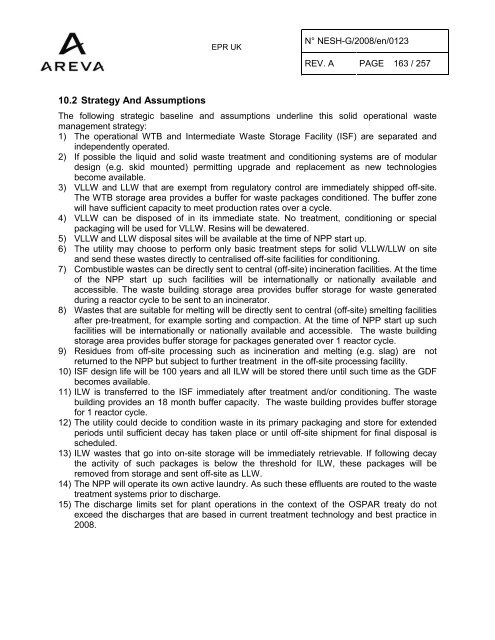Solid Radioactive Waste Strategy Report.pdf - UK EPR
Solid Radioactive Waste Strategy Report.pdf - UK EPR
Solid Radioactive Waste Strategy Report.pdf - UK EPR
Create successful ePaper yourself
Turn your PDF publications into a flip-book with our unique Google optimized e-Paper software.
<strong>EPR</strong> <strong>UK</strong><br />
N° NESH-G/2008/en/0123<br />
REV. A PAGE 163 / 257<br />
10.2 <strong>Strategy</strong> And Assumptions<br />
The following strategic baseline and assumptions underline this solid operational waste<br />
management strategy:<br />
1) The operational WTB and Intermediate <strong>Waste</strong> Storage Facility (ISF) are separated and<br />
independently operated.<br />
2) If possible the liquid and solid waste treatment and conditioning systems are of modular<br />
design (e.g. skid mounted) permitting upgrade and replacement as new technologies<br />
become available.<br />
3) VLLW and LLW that are exempt from regulatory control are immediately shipped off-site.<br />
The WTB storage area provides a buffer for waste packages conditioned. The buffer zone<br />
will have sufficient capacity to meet production rates over a cycle.<br />
4) VLLW can be disposed of in its immediate state. No treatment, conditioning or special<br />
packaging will be used for VLLW. Resins will be dewatered.<br />
5) VLLW and LLW disposal sites will be available at the time of NPP start up.<br />
6) The utility may choose to perform only basic treatment steps for solid VLLW/LLW on site<br />
and send these wastes directly to centralised off-site facilities for conditioning.<br />
7) Combustible wastes can be directly sent to central (off-site) incineration facilities. At the time<br />
of the NPP start up such facilities will be internationally or nationally available and<br />
accessible. The waste building storage area provides buffer storage for waste generated<br />
during a reactor cycle to be sent to an incinerator.<br />
8) <strong>Waste</strong>s that are suitable for melting will be directly sent to central (off-site) smelting facilities<br />
after pre-treatment, for example sorting and compaction. At the time of NPP start up such<br />
facilities will be internationally or nationally available and accessible. The waste building<br />
storage area provides buffer storage for packages generated over 1 reactor cycle.<br />
9) Residues from off-site processing such as incineration and melting (e.g. slag) are not<br />
returned to the NPP but subject to further treatment in the off-site processing facility.<br />
10) ISF design life will be 100 years and all ILW will be stored there until such time as the GDF<br />
becomes available.<br />
11) ILW is transferred to the ISF immediately after treatment and/or conditioning. The waste<br />
building provides an 18 month buffer capacity. The waste building provides buffer storage<br />
for 1 reactor cycle.<br />
12) The utility could decide to condition waste in its primary packaging and store for extended<br />
periods until sufficient decay has taken place or until off-site shipment for final disposal is<br />
scheduled.<br />
13) ILW wastes that go into on-site storage will be immediately retrievable. If following decay<br />
the activity of such packages is below the threshold for ILW, these packages will be<br />
removed from storage and sent off-site as LLW.<br />
14) The NPP will operate its own active laundry. As such these effluents are routed to the waste<br />
treatment systems prior to discharge.<br />
15) The discharge limits set for plant operations in the context of the OSPAR treaty do not<br />
exceed the discharges that are based in current treatment technology and best practice in<br />
2008.

















